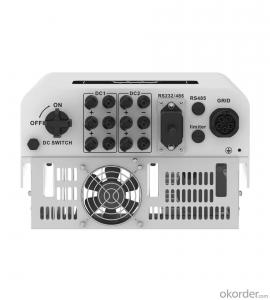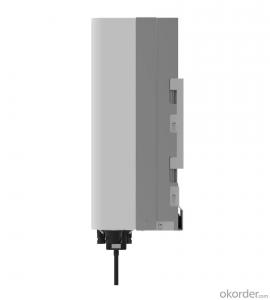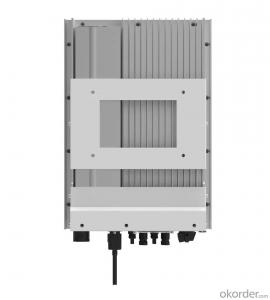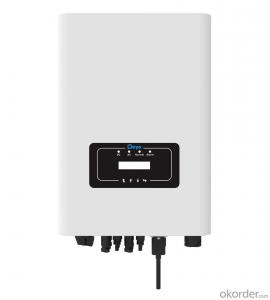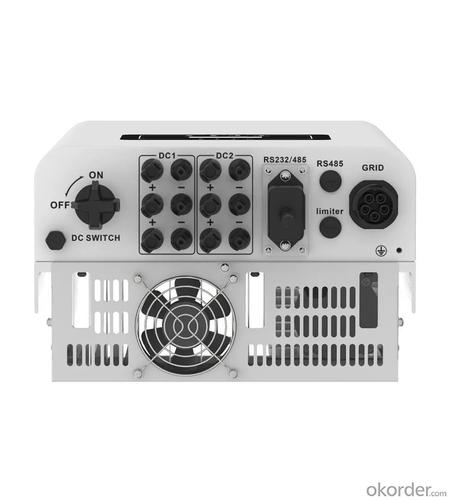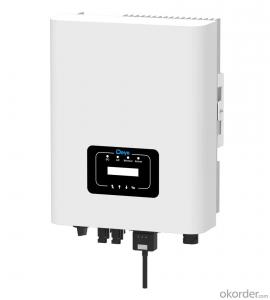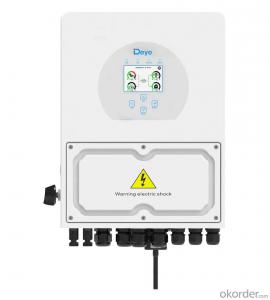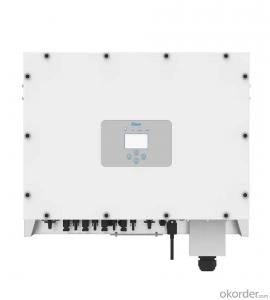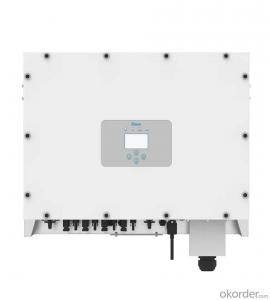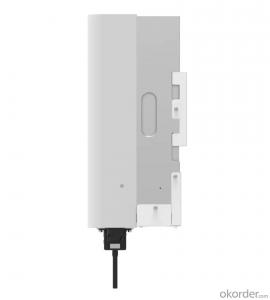3500 Watt Solar Inverter - Sun-10/12/15k-G03-LV | 10-15kW | Three Phase | 2 MPPT | Low Voltage | 127/220VAC
- Loading Port:
- Ningbo
- Payment Terms:
- TT OR LC
- Min Order Qty:
- 100 pc
- Supply Capability:
- 5000 pc/month
OKorder Service Pledge
OKorder Financial Service
You Might Also Like
Specification
| Technical Data | |||||
| Model | SUN-10K-G03-LV | SUN-12K-G02-LV | SUN-15K-G02-LV | ||
| Input Side | |||||
| Max. DC Input Power (kW) | 13 | 15.6 | 19.5 | ||
| Max. DC Input Voltage (V) | 800 | ||||
| Start-up DC Input Voltage (V) | 250 | ||||
| MPPT Operating Range (V) | 200~700 | ||||
| Max. DC Input Current (A) | 32+32 | ||||
| Max. Short Circuit Current (A) | 48+48 | ||||
| Number of MPPT / Strings per MPPT | 2/2 | ||||
| Output Side | |||||
| Rated Output Power (kW) | 10 | 12 | 15 | ||
| Max. Active Power (kW) | 11 | 13.2 | 16.5 | ||
| Nominal Output Voltage / Range (V) | 3L/N/PE 127/0.85Un-1.1Un,220 /0.85Un-1.1Un (this may vary with grid standards) | ||||
| Rated Grid Frequency (Hz) | 60 / 50 (Optional) | ||||
| Operating Phase | Three phase | ||||
| Rated AC Grid Output Current (A) | 26.2 | 31.5 | 39.4 | ||
| Max. AC Output Current (A) | 28.9 | 34.6 | 43.3 | ||
| Output Power Factor | 0.8 leading to 0.8 lagging | ||||
| Grid Current THD | <3% | ||||
| DC Injection Current (mA) | <0.5% | ||||
| Grid Frequency Range | 57~62 | ||||
| Efficiency | |||||
| Max. Efficiency | 98.6% | ||||
| Euro Efficiency | 98% | ||||
| MPPT Efficiency | >99% | ||||
| Protection | |||||
| DC Reverse-Polarity Protection | Yes | ||||
| AC Short Circuit Protection | Yes | ||||
| AC Output Overcurrent Protection | Yes | ||||
| Output Overvoltage Protection | Yes | ||||
| Insulation Resistance Protection | Yes | ||||
| Ground Fault Monitoring | Yes | ||||
| Anti-islanding Protection | Yes | ||||
| Temperature Protection | Yes | ||||
| Integrated DC Switch | Yes | ||||
| Remote software upload | Yes | ||||
| Remote change of operating parameters | Yes | ||||
| Surge protection | DC Type II / AC Type II | ||||
| General Data | |||||
| Size (mm) | 330W×508H×206D | ||||
| Weight (kg) | 20.8 | ||||
| Topology | Transformerless | ||||
| Internal Consumption | <1W (Night) | ||||
| Running Temperature | -25~65℃, >45℃ derating | ||||
| Ingress Protection | IP65 | ||||
| Noise Emission (Typical) | <45 dB | ||||
| Cooling Concept | Smart cooling | ||||
| Max. Operating Altitude Without Derating | 2000m | ||||
| Warranty | 5 years | ||||
| Grid Connection Standard | CEI 0-21, VDE-AR-N 4105, NRS 097, IEC 62116, IEC 61727, G99, G98, VDE 0126-1-1, RD 1699, C10-11 | ||||
| Operating Surroundings Humidity | 0-100% | ||||
| Safety EMC / Standard | IEC/EN 61000-6-1/2/3/4, IEC/EN 62109-1, IEC/EN 62109-2 | ||||
| Features | |||||
| DC Connection AC Connection Display Interface | MC-4 mateable | ||||
| AC Connection | IP65 rated plug | ||||
| Display | LCD1602 | ||||
| Interface | RS485/RS232/Wifi/LAN | ||||
27/220Vac and 60Hz, three phase system
2 MPP tracker, Max. efficiency up to 98.6%
Zero export application, VSG application
String intelligent monitoring (optional)
Wide output voltage range
Anti-PID function (Optional)
This series inverter is specially designed for 127/220Vac three-phase system, especially suits for South American areas. With compactness design, easy to install and operate. It supports wide AC output voltage to adapt to poor grid, extending the inverter working hours.
- Q: What are the indicators of a faulty solar inverter?
- Some indicators of a faulty solar inverter include, but are not limited to, a sudden drop in power output, unusual noises or vibrations coming from the inverter, error messages or warning lights displayed on the inverter's screen, frequent shutdowns or restarts, and a lack of communication or connection with the solar monitoring system.
- Q: How does a solar inverter protect against power surges?
- A solar inverter protects against power surges by using built-in surge protection devices such as metal oxide varistors (MOVs) or transient voltage suppressors (TVS). These devices act as a barrier, diverting excess voltage from entering the inverter and the connected solar panels. This prevents damage to the inverter and other sensitive electronic components by ensuring that the voltage stays within safe limits.
- Q: How do you calculate the power output of a solar inverter?
- The power output of a solar inverter can be calculated by multiplying the DC voltage input from the solar panels by the DC current output. This will give you the DC power output. To calculate the AC power output, you need to consider the efficiency of the inverter. Multiply the DC power output by the inverter efficiency to determine the AC power output.
- Q: What is the purpose of a solar inverter?
- The purpose of a solar inverter is to convert the direct current (DC) electricity generated by solar panels into alternating current (AC) electricity that can be used to power household appliances and be fed back into the electrical grid.
- Q: Can a solar inverter be used with solar-powered agricultural equipment?
- Yes, a solar inverter can be used with solar-powered agricultural equipment. A solar inverter is an essential component in a solar power system as it converts the DC (direct current) electricity generated by solar panels into AC (alternating current) electricity that can be used to power various equipment, including agricultural machinery.
- Q: Can a solar inverter be used in areas with high levels of lightning activity?
- Yes, a solar inverter can be used in areas with high levels of lightning activity. However, it is important to ensure that the inverter is designed to withstand lightning strikes and has appropriate surge protection measures in place to prevent damage. Additionally, proper grounding and installation by a qualified professional are crucial to mitigate any potential risks associated with lightning strikes.
- Q: What is the role of a power monitoring feature in a solar inverter?
- The role of a power monitoring feature in a solar inverter is to track and measure the amount of power generated by the solar panels. It provides real-time data on the energy production, allowing users to monitor the system's performance, identify any issues or inefficiencies, and optimize the overall energy output. This feature is crucial for ensuring the effective and efficient operation of a solar power system.
- Q: Can a solar inverter be used with a time-of-use electricity tariff?
- Yes, a solar inverter can be used with a time-of-use electricity tariff. Time-of-use electricity tariffs typically involve different rates for electricity consumption based on the time of day. A solar inverter can be programmed to produce and export excess solar energy during peak times when electricity rates are higher, and import energy from the grid during off-peak times when rates are lower. This allows users to optimize their energy consumption and potentially save on electricity costs.
- Q: Can a solar inverter be used in commercial applications?
- Yes, a solar inverter can be used in commercial applications. Commercial buildings can install solar panels and connect them to a solar inverter, which converts the DC power generated by the panels into usable AC power for the building's electrical system. This allows commercial establishments to harness solar energy and reduce their reliance on traditional grid power sources, resulting in cost savings and environmental benefits.
- Q: Can a solar inverter be installed indoors?
- Yes, a solar inverter can be installed indoors.
Send your message to us
3500 Watt Solar Inverter - Sun-10/12/15k-G03-LV | 10-15kW | Three Phase | 2 MPPT | Low Voltage | 127/220VAC
- Loading Port:
- Ningbo
- Payment Terms:
- TT OR LC
- Min Order Qty:
- 100 pc
- Supply Capability:
- 5000 pc/month
OKorder Service Pledge
OKorder Financial Service
Similar products
Hot products
Hot Searches
Related keywords
